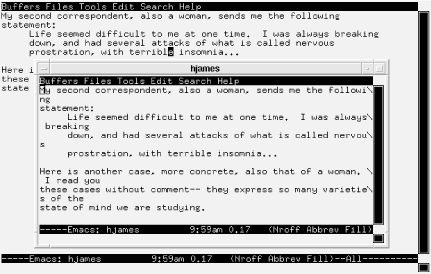Using Multiple X Windows
If you use the X Window System, you aren’t limited to Emacs windows; you can also use multiple X windows, referred to in Emacs as frames, for the sake of distinguishing them from the Emacs windows we’ve already discussed.
Emacs has a whole set of commands dealing with frames that are similar to the window commands. For example, to find a file in another window, the command is C-x 4 f; to find one in another frame, the command is C-x 5 f.
Working with Frames
To open a new frame, select Make New Frame from the Files menu or press C-x 5 2 (for make-frame). Emacs makes a new frame containing the current buffer and puts it on top of the current frame.
If your new frame completely overlaps your current frame, you may need to size the new frame to tell them apart. For a more convenient solution, add these lines to your .emacs file:
(setq initial-frame-alist '((width . 75) (height . 34))) (setq default-frame-alist '((width . 60) (height . 20)))
These lines set up sizes for the width and height of Emacs frames. The first frame will be the size set in initial-frame-alist (in this example, 75 characters wide by 34 lines high), and subsequent frames, specified by default-frame-alist, will be 60 characters wide and 20 characters high. Depending on your display, you can make these numbers smaller or larger.
Type: C-x 5 2 (see Figure 4-3):

Figure 5-3. Emacs opens a new frame ...
Get Learning GNU Emacs, Second Edition now with the O’Reilly learning platform.
O’Reilly members experience books, live events, courses curated by job role, and more from O’Reilly and nearly 200 top publishers.

